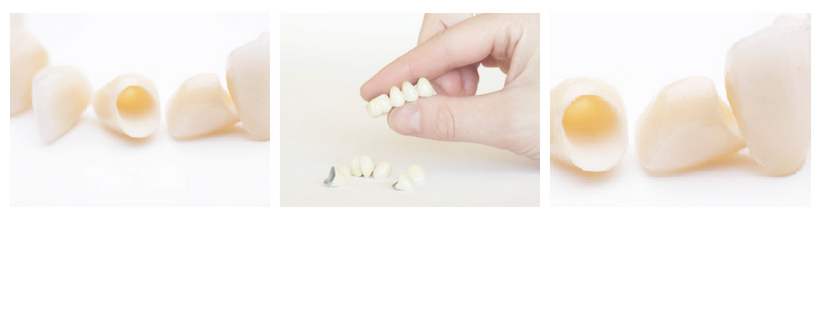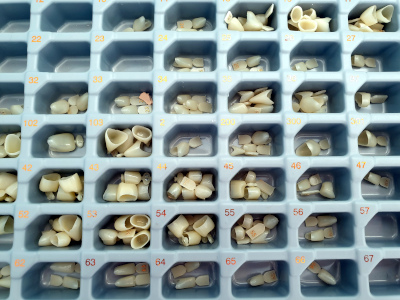
The dental crown is an “artificial cap”, which covers the tooth and is produced in a laboratory. It is a tooth shaped cover used to conceal damage and is accurately adjusted to the tooth.
Dental Crowns and bridges are cemented using special glues to adjust them to the gum line, completely covering the tooth.
Well-designed crowns will serve as an unnoticeable artificial cap. Also known as fixed prosthesis, they cannot be removed by the patient. Only a clinical dentist will be able to remove them.
Dental crowns and bridges
Why would I need a crown?
- Dental crowns improve aesthetics. The aesthetic of the tooth can be improved both in terms of shape and shading.
- Colour can be corrected and chosen, according to the patient’s preferences or the adjacent structures. In the case of yellowish teeth, crowns can be produced with a selected shading, making them clearer and whiter.
- Crowns can correct the angle and inclination of the teeth. Misaligned teeth can have crowns with a correct angle in order to harmoniously position them in the dental arch.
- They protect weak, devitalised, fractured teeth, and poor looking teeth with old restorations.
- Crowns are adaptable to implantology and are used to support a dental implant. These crowns can be screwed or cemented to a titanium structure. Immediate Loading Protocols adapt them to the immediate prosthesis.
Dental Crown Types
Fixed dental crowns can be temporary or permanent.
-

Dental Crown Types, temporaries Temporaries dental crowns: can be made of stainless steel or acrylic material and filled in with composite and special cements. They are available at clinics in various sizes and shapes and are immediately applicable.
- Permanents dental crowns: are made of pure ceramic or zirconium and may have a metal structure, which will be coated with ceramic. These dental crowns are produced in the laboratory and are tested during the production process.
Stainless Crowns
Stainless Crowns are considered temporary and are usually used in paediatric dentistry. They are not custom-made in a laboratory, as opposed to permanent crowns.
These types of crowns are available at the clinics in different pre-fabricated sizes and are used to coat baby teeth in order to protect them. They may also be used to prevent excessive sensitivity or tooth decay.
They protect deciduous teeth on children as a prophylactic measure. When the baby tooth falls out, the stainless crown will fall out as well. If needed, they can also be extracted together with the tooth.
Zirconium Dental Crowns or Pure Ceramic (metal free)
Zirconium is a type of ceramic used to make crowns, bridges, and abutments.
This ceramic has a beautiful crystal colour, very close to its natural colour. For this reason, these crowns are recommended for visible teeth or when the aesthetic is very important.
People who suffer from metal allergies can choose these metal-free structures. They are less resistant than metal ceramic crowns, but in terms of the aesthetics, are the best available option.
Metal Ceramic Dental Crowns
Its structure has metal or iron, such as palladium, nickel, or chromium. Later, it is coated with ceramic. These structures are highly resistant to the pressure caused by chewing. Their greatest inconvenience is that when they are subjected to extreme pressure, the ceramic layer may chip or break. Just as our teeth might break when biting hard foods, the same can happen with these ceramic crowns when subjected to extreme pressure.
Metal will not likely break, but the ceramic coating is more fragile and may chip. However, repairing it in the laboratory is easy and effective, and it can be placed on the teeth again. Another inconvenience is receding gums.
Over the years, gums may shrink and that will make the metal under the ceramic visible. In this case, a dark line will appear between the crown and gums. To avoid this result, these crowns are used on the back teeth where the aesthetic is not so important.
Acrylic Dental Crowns can be temporary or permanent. The quality of acrylic makes these dental crowns less resistant and more likely to wear out over the years. However, they are more affordable and beautiful. For this reason, sometimes these crowns are used as a replacement for expensive ceramic crowns. Acrylic crowns can be used to solve aesthetic issues, fractures, and yellowish teeth.
Dental Bridges
Zirconium Dental Bridges, Metal Ceramic Bridges
Bridges are prosthetic restorations for one or more missing teeth. There are zirconium bridges or metal ceramic bridges, which are placed over a tooth or over an implant. When placed over a tooth, it is known as “cemented” over a tooth root with a specific material.
To ensure successful treatment, the root of the tooth must be in excellent condition.
Dental Bridge
A dental bridge is anchored on the neighbouring teeth. It consists of a false tooth known as a ‘pontic’, which is flanked by two crowns. These ‘pontics’ are placed in the gum to fill the gaps, while the crowns are fixed on the roots of the tooth. This structure is called the bridge.
Thanks to recent medical advances, bridges can be fixed over an implants, even when there is no root to support it. In this case, it is not necessary to use the remaining teeth to fixate them. Bridges are supported by dental implants that replace the root of the tooth.
Ceramic metal bridges have a metal structure, which makes them more robust and resistant. Later, bridges will be coated with the chosen ceramic shade.
The dentist will choose the shade according to a universally-established colour scale and the patient’s adjacent teeth. Bridges are made in a dental laboratory and a material, such as Ivocal Vivadent ceramics, is used to coat them. These ceramics are distinguishable for their translucency and high aesthetical value.
How Much Do Dental Crowns Cost?
Ceramic crowns cost 450-600 Euros per tooth. Not including root canals or panoramic x-rays.

